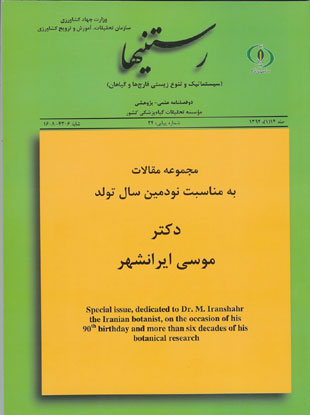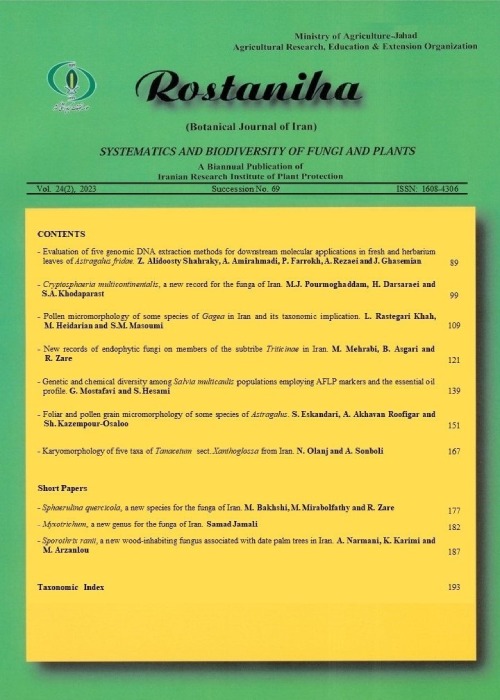فهرست مطالب

نشریه رستنیها
سال چهاردهم شماره 1 (پیاپی 44، بهار و تابستان 1392)
- تاریخ انتشار: 1392/05/20
- تعداد عناوین: 11
-
-
Page 3This brief biography is consecrated to a scientist who has spent more than sixty years of his life on the study of Iranian plants and made a significant contribution to our knowledge of botany in Iran. Dr. Musa Iranshahr was born on 7 December 1923 in Tabriz (Iran). He did his elementary and high school where he was born. After graduating from Faculty of Agriculture, Tehran University, he received his doctorate in Agriculture from «Die Universität Für Bodenkulter, Wien» in 1977 and then worked in the Technical Office, Forest Organization and Training Office. In 1966, following his love and interest to Botany, he joined Dr. Esfandiari, his former teacher and E. Behboudi, an old friend in «IRAN» Herbarium of Iranian Research Institute of Plant Protection (formerly named «EVIN» Herbarium of Plant Pests and Diseases Research Institute) at Tehran. Dr. Iranshahr was appointed as the head of the Department of Botany as well as «IRAN» Herbarium in 1975, and kept this position until 1979, when he was retired. However, his intensive research collaboration with the Herbarium continues till present. Dr. Irashsahr never stopped his struggle for the advancement of botany in Iran and enrichment of «IRAN» Herbarium. He traveled over 60, 000 km and has spent more than 500 days in mountains, forests, deserts and plains of Iran, alone or together with other botanists, namely, Rechinger, Alava, Riedl, Renz, Lamond, Ershad, Termeh, Moussavi, etc. collecting plant species. A few plant species discovered and described from Iran were named after him in recognition of his contribution to botanical science in Iran. He authored 37 new taxa and over 36 scientific papers and books in botany. His devotion to research activities has left him little time to take executive or educational positions, but he never refused to train and support younger botany enthusiasts. Those who had the opportunity to attend his lectures have much to say about how love can bring together knowledge and humbleness in a man.
-
Page 6A taxonomic overview of the genus Anticharis (Scrophulariaceae) especially in Namibia and Angola is presented. Three new species are described, viz. A. namibensis B. Nord., A. kaokoensis B. Nord. and A. angolensis B. Nord. A key to the Anticharis species of Namibia and Angola is presented. Some aspects of phytogeography, molecular phylogeny and photosynthetic pathways (C3-C4) are briefly discussed.Keywords: C4 photosynthetic pathway, Lamiales, new species
-
Page 14Five new Astragalus species from section Malacothrix Bunge, namely, A. musaianus Maassoumi & Joharchi sp. nov., A. neo-iranshahrii Maassoumi & Amini Rad sp. nov., A. pseudocomosus Maassoumi, F. Ghahrem. & Bagheri sp. nov., A. subaspadanus Maassoumi, F. Ghahrem. & Bagheri sp. nov. and A. takabensis Maasoumi & Maroofi are described and illustrated. These are endemic from different parts of Iran. New species are compared with their nearest relatives.
-
Page 22A provisional list of all the endemic vascular plant genera in SW Asia is presented. The area, here defined to include Turkey, the Caucasus, N Iraq, Iran, Afghanistan and adjacent parts of Pakistan and Central Asia, has 161 genera restricted to it. By far, the greatest numbers of the endemic genera are in Apiaceae, Brassicaceae and Asteraceae; many are morphologically isolated and occur at random throughout the area. Non-endemic genera with relevant distributions in the area are also discussed, several having a major concentration in Central Asia/Afghanistan and radiate westwards from there reaching a limit in SE Turkey/N Iraq. Also in these and other non-endemic genera, there are many species confined to the west (Turkey) or the east (Afghanistan) but very few are distributed throughout. The paper attempts to provide a framework for future research. It draws attention to the need for a more precise terminology in discussing phytochoria and questions the validity of many currently widely used terms including Irano-Turanian.Keywords: Central Asia, endemism, Irano, Turanian, phytogeography
-
Page 36Angelica urumiensis Mozaff. and Eryngium iranicum Mozaff. are described as new species from Iran. Aphanopleura trachysperma Boiss. and Pastinaca sativa L. subsp. urens (Req. ex Gordon) Celak are reported as new records from Iran.Keywords: Angelica, Aphanopleura, Eryngium, Irano, Turanian area, Pastinaca, Umbelliferae
-
Page 43In Armenia, Nymphaea alba only occurs in a small area NW of Stepanavan. It is restricted to small lakes with a minimum depth of c. 2–3 m because in shallower lakes it may be out-competed by Typha or Schoenoplectus species.Keywords: Distribution map, flora of Armenia, NW Stepanavan
-
Page 48When worked out the treatment of Artemisia for Flora Iranica, in several cases no good, determinable material was available, especially from outside of Afghanistan, namely, Iran and the neighbouring Middle Asian regions. This was especially a problem for species of the homogamous group Serephidium. During the work on very rich new material of this group from Iran, collected by V. Mozaffarian (Tehran) and the investigation of material from the neighbouring Middle Asia several errors in the Flora Iranica treatment could be corrected and some species more clearly defined. In this paper some species of Artemisia in Afghanistan, which were treated wrongly in former time, are clarified.Keywords: Anthemideae, Compositae, flora Iranica, taxonomy
-
Page 59
In Iran, the Lamiaceae family is represented by 46 genera, 406 species and 97 infraspecific taxa; of these, 165 taxa are endemic. The distribution of family in Iran covers the whole country but the species number decreases from the centre towards the east, south-east and south. The distribution pattern of endemic taxa shows that Chaharmahal-va- Bakhtiari, Esfahan, Fars, Tehran, Azarbayejan, Kohgiloueh-va-Boirahamad, Lurestan and Hamadan provinces are the hot spots for speciation of the family and in these provinces most of the endemic taxa occur. From the conservation point of view, 14 species are suspected of being extinct, or very rare and 55 taxa rare and endangered and are in a critical condition because of their narrow distribution. These taxa have been recorded only from one location in Iran and need special attention and must be considered in conservation programs. Nonetheless, there are a few species with very wide distributions and high frequency. Some of these species occur in ruderal or disturbed habitats.
Keywords: Distribution pattern, endemics, flora of Iran, Labiatae -
Page 68Suaeda iranshahrii Akhani & Freitag, previous specimens cited as S. maritima, is described as a new species of sect. Brezia endemic to the coasts of the Persian Gulf; it is subdivided into the type variety distributed along the Persian side and var. arabica Freitag from the Arabian shore. The new species is named in honour of Dr. Musa Iranshahr, the eminent Iranian botanist to whom this Festschrift is dedicated on the occasion of his 9 th birthday. The species is an important component of plant communities on tidal mudflats. Molecular, anatomical and caryological evidence pointed to S. crassifolia as the closest relative and putative progenitor.Keywords: Amaranthaceae, anatomy, cytology, halophytes, phylogeny, SW Asian flora
-
Page 81Among Allium plants newly collected in NW Iran, a voucher was identified as A. pseudostrictum. This is a new record for Iran. A morphological description and a key for determination are presented and the taxonomic relations and distribution in Iran are also discussed.Keywords: Allium, distribution, morphological description
-
Page 85According to previous studies, the genus Rheum in Iran includes four species: R. turkestanicum Janisch., R. persicum Losinsk., R. ribes L. and R. khorasanicum Baradaran & Jafari. During the long term study, based on field and many herbaria specimens, three new species including R. iranshahrii Taheri & Assadi sp. nov., R. kordestanicum Taheri & Assadi sp. nov. and R. austro-iranicum Taheri & Assadi sp. nov. were discovered in Iran. In this paper, all new species are compared with their putative relatives. Botanical characters are elaborated and a brief taxonomic synopsis for all accepted species is also provided.Keywords: Flora of Iran, Rhubarb, taxonomy


